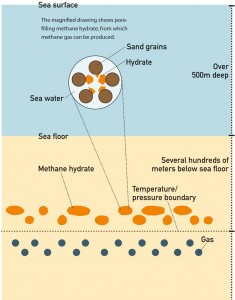Methane Hydrate Researchers' keyword commentaries

Methane hydrate is attracting much attention as a domestic energy resource for the future. Methane hydrate is the main component of natural gas and is a solid substance similar to ice, in which methane is trapped within a cage structure composed of water molecules under high-pressure and low-temperature conditions. On putting a lighter close to the substance, the cage structure is broken and methane begins to burn, and so methane hydrate is also known as “fiery ice.” In nature, methane hydrate exists in permafrost areas and in deep water sedimentary layers. It is worth noting that the total amount of the substance is estimated to be more than half of all the organic carbons present on the Earth. The substance is estimated to exist in large amounts also around offshore Japan. It originates from organic matter which is abundantly supplied from steep mountains on land. Methane hydrate is indeed a blessing of nature resulting from Japan’s natural environment in which we have both steep mountains and a deep ocean floor. Not only Japan, but also the United States, Canada, India, South Korea, China, and other countries are implementing projects to use this substance as a resource towards commercial production by around 2020. The technological challenges include how to find methane rich deposits, produce solid methane hydrate, and develop environmentally friendly methods of extraction. It is thought that the most effective means of extracting methane is depressurization-induced dissociation in the underground methane hydrate-bearing layer. Production tests conducted in permafrost areas in Canada have suggested that this method will be effective. In Japan the world’s first ocean production test was successfully conducted in March 2013. I believe it is important for us to realize that because of Japan’s natural environment, which was created by dynamic movements in the Earth’s crust, we can utilize methane hydrate to develop a new local industry in Japan, which currently depends on imported energy and resources.
Associate Professor Jun Matsushima
Graduate School of Engineering
Frontier Research Center for Energy and Resources (Japanese)
(This article first appeared in the tenth issue of Tansei.)







